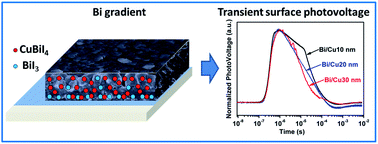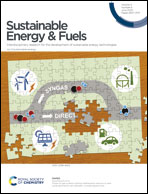Gradient formation and charge carrier dynamics of CuBiI4 based perovskite-like solar cells†
Abstract
Designing lead-free inorganic perovskite or perovskite-like structure materials and researching the corresponding photoinduced charge carrier dynamics are always promising due to both the environment and power conversion efficiency considerations. In this work, we intelligently employ a bilayer metal Bi/Cu thin film with different atomic ratios as the precursor to fabricate a CuBiI4 perovskite-like film in situ with a controlled Bi gradient at room temperature. This structure can significantly affect the photoinduced charge carrier dynamics of the resulting products. Next, a series of transient surface photovoltage (TSPV) measurements are carried out to investigate the photoinduced charge carrier dynamics of such CuBiI4 and CuBiI4:organic hybrid thin films. The results reveal that the gradually decreasing Bi content from ITO to CuBiI4 can facilitate the photoinduced charge carrier transportation. Finally, a champion PCE of 1.10% is obtained for an ITO/CuBiI4:polythieno[3,4-b]-thiophene-co-benzodithiophene (PTB7)/Au solar cell device. In particular, we find an exact negative correlation of the defined parameter L (the defined value for evaluating the photoinduced charge carrier dynamics in TSPV measurements) with the corresponding PCE of various devices for the first time, which may pave a new way for evaluating the potential photoelectric and photovoltaic performances of new materials without the assembly of solar cell devices.



 Please wait while we load your content...
Please wait while we load your content...